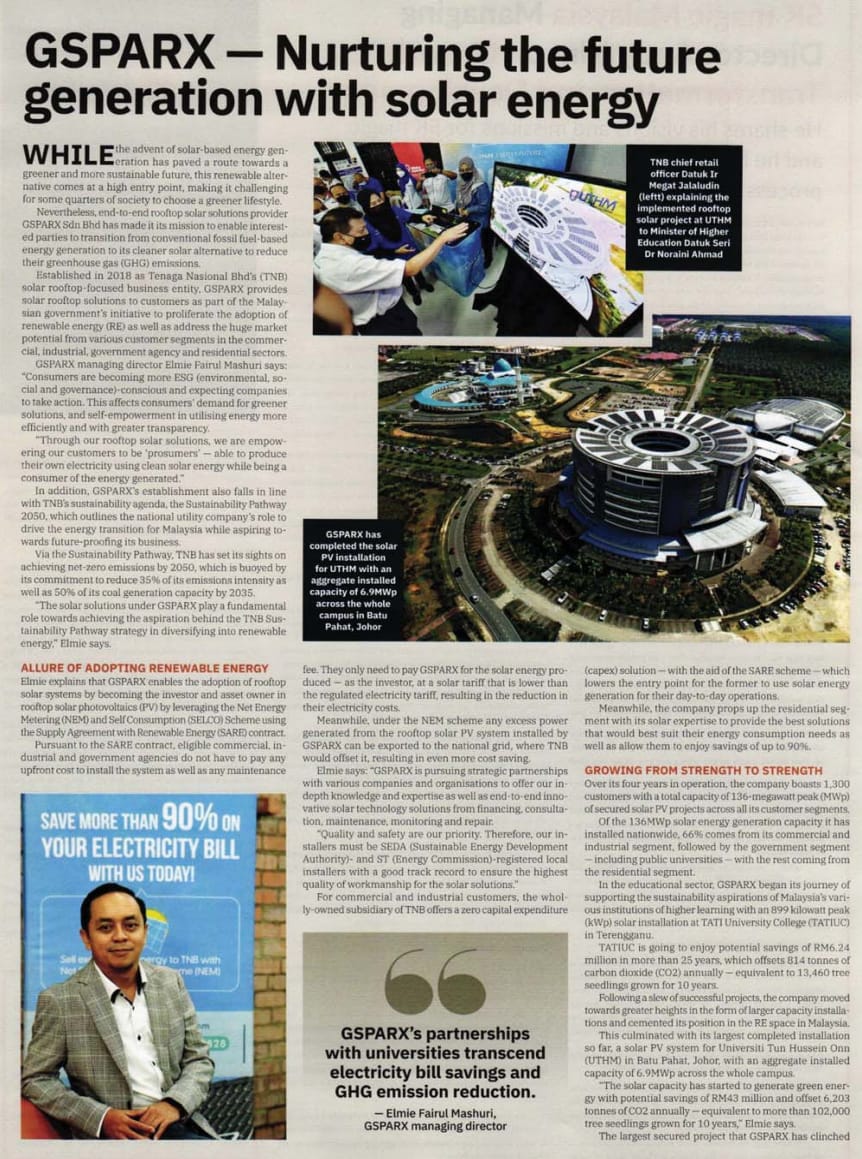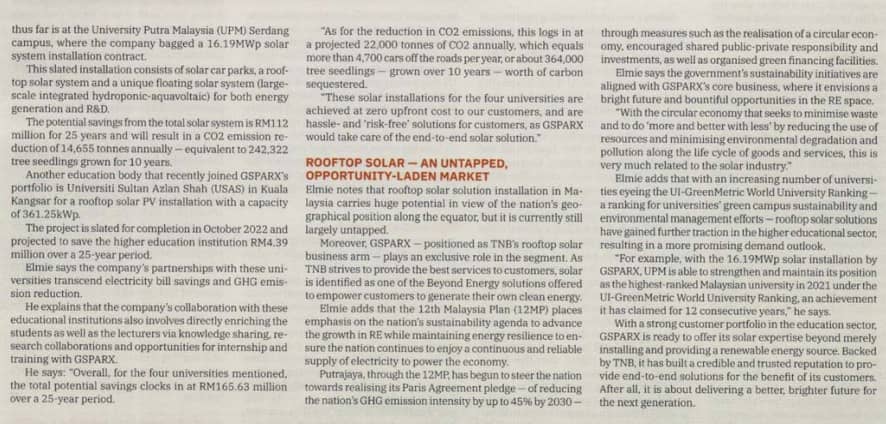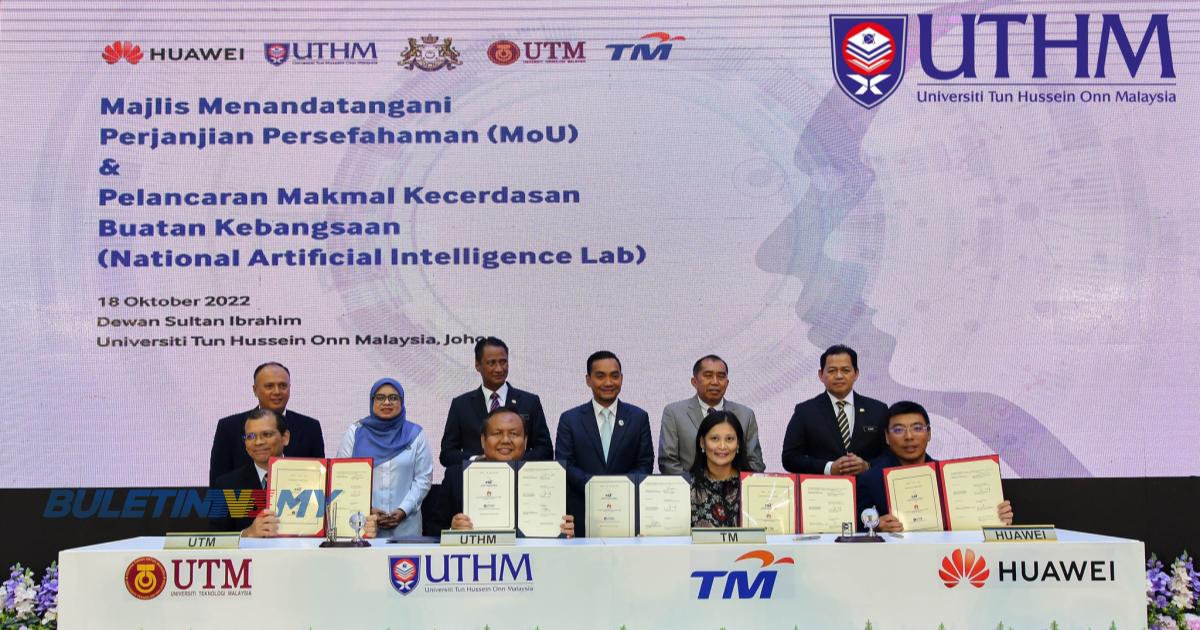
The Edge, 29 August 2022 :


WHILE the advent of solar-based energy generation has paved a route towards a greener and more sustainable future, this renewable alternative comes at a high entry point, making it challenging for some quarters of society to choose a greener lifestyle.
Nevertheless, end-to-end rooftop solar solutions provider GSPARX Sdn. Bhd. has made it its mission to enable interested parties to transition from conventional fossil fuel-based energy generation to its cleaner solar alternative to reduce their greenhouse gas (GHG) emissions.
Established in 2018 as Tenaga Nasional Bhd’s (TNB) solar rooftop-focused business entity, GSPARX provides solar rooftop solutions to customers as part of the Malaysian government’s initiative to proliferate the adoption of renewable energy (RE) as well as address the huge market potential from various customer segments in the commercial, industrial, government agency and residential sectors.
GSPARX managing director Elmie Fairul Mashuri says: “Consumers are becoming more ESG (environmental, social and governance)-conscious and expecting companies to take action. This affects consumers’ demand for greener solutions, and self-empowerment in utilising energy more efficiently and with greater transparency.
“Through our rooftop solar solutions, we are empowering our customers to be ‘prosumers’ — able to produce their own electricity using clean solar energy while being a consumer of the energy generated.”
In addition, GSPARX’s establishment also falls in line with TNB’s sustainability agenda, the Sustainability Pathway 2050, which outlines the national utility company’s role to drive the energy transition for Malaysia while aspiring towards future-proofing its business.
Via the Sustainability Pathway, TNB has set its sights on achieving net-zero emissions by 2050, which is buoyed by its commitment to reduce 35% of its emissions intensity as well as 50% of its coal generation capacity by 2035.
“The solar solutions under GSPARX play a fundamental role towards achieving the aspiration behind the TNB Sustainability Pathway strategy in diversifying into renewable energy,” Elmie says.
ALLURE OF ADOPTING RENEWABLE ENERGY
Elmie explains that GSPARX enables the adoption of rooftop solar systems by becoming the investor and asset owner in rooftop solar photovoltaics (PV) by leveraging the Net Energy Metering (NEM) and Self Consumption (SELCO) Scheme using the Supply Agreement with Renewable Energy (SARE) contract.
Pursuant to the SARE contract, eligible commercial, industrial and government agencies do not have to pay any upfront cost to install the system as well as any maintenance fee. They only need to pay GSPARX for the solar energy produced — as the investor, at a solar tariff that is lower than the regulated electricity tariff, resulting in the reduction in their electricity costs.
Meanwhile, under the NEM scheme any excess power generated from the rooftop solar PV system installed by GSPARX can be exported to the national grid, where TNB would offset it, resulting in even more cost saving.
Elmie says: “GSPARX is pursuing strategic partnerships with various companies and organisations to offer our indepth knowledge and expertise as well as end-to-end innovative solar technology solutions from financing, consultation, maintenance, monitoring and repair.
“Quality and safety are our priority. Therefore, our installers must be SEDA (Sustainable Energy Development Authority)- and ST (Energy Commission)-registered local installers with a good track record to ensure the highest quality of workmanship for the solar solutions.”
For commercial and industrial customers, the wholly-owned subsidiary of TNB offers a zero capital expenditure i GSPARX’s partnerships with universities transcend electricity bill savings and GHG emission reduction. — Elmie Fairul Mashuri, GSPARX managing director (capex) solution — with the aid of the SARE scheme — which lowers the entry point for the former to use solar energy generation for their day-to-day operations.
Meanwhile, the company props up the residential segment with its solar expertise to provide the best solutions that would best suit their energy consumption needs as well as allow them to enjoy savings of up to 90%.
GROWING FROM STRENGTH TO STRENGTH
Over its four years in operation, the company boasts 1,300 customers with a total capacity of 136-megawatt peak (MWp) of secured solar PV projects across all its customer segments.
Of the 136MWp solar energy generation capacity it has installed nationwide, 66% comes from its commercial and industrial segment, followed by the government segment — including public universities — with the rest coming from the residential segment.
In the educational sector, GSPARX began its journey of supporting the sustainability aspirations of Malaysia’s various institutions of higher learning with an 899 kilowatt peak (kWp) solar installation at TATI University College (TATIUC) in Terengganu.
TATIUC is going to enjoy potential savings of RM6.24 million in more than 25 years, which offsets 814 tonnes of carbon dioxide (C02) annually — equivalent to 13,460 tree seedlings grown for 10 years.
Following a slew of successful projects, the company moved towards greater heights in the form of larger capacity installations and cemented its position in the RE space in Malaysia.
This culminated with its largest completed installation so far, a solar PV system for Universiti Tun Hussein Onn (UTHM) in Batu Pahat, Johor, with an aggregate installed capacity of 6.9MWp across the whole campus.
“The solar capacity has started to generate green energy with potential savings of RM43 million and offset 6,203 tonnes of C02 annually — equivalent to more than 102,000 tree seedlings grown for 10 years,” Elmie says.
The largest secured project that GSPARX has clinched thus far is at the University Putra Malaysia (UPM) Serdang campus, where the company bagged a 16.19MWp solar system installation contract.
This slated installation consists of solar car parks, a rooftop solar system and a unique floating solar system (largescale integrated hydroponic-aquavoltaic) for both energy generation and R&D.
The potential savings from the total solar system is RM112 million for 25 years and will result in a C02 emission reduction of 14,655 tonnes annually – equivalent to 242,322 tree seedlings grown for 10 years.
Another education body that recently joined GSPARX’s portfolio is Universiti Sultan Azlan Shah (USAS) in Kuala Kangsar for a rooftop solar PV installation with a capacity of 361.25kWp.
The project is slated for completion in October 2022 and projected to save the higher education institution RM4.39 million over a 25-year period.
Elmie says the company’s partnerships with these universities transcend electricity bill savings and GHG emission reduction.
He explains that the company’s collaboration with these educational institutions also involves directly enriching the students as well as the lecturers via knowledge sharing, research collaborations and opportunities for internship and training with GSPARX.
He says: “Overall, for the four universities mentioned, the total potential savings clocks in at RM165.63 million over a 25-year period.
“As for the reduction in C02 emissions, this logs in at a projected 22,000 tonnes of C02 annually, which equals more than 4,700 cars off the roads per year, or about 364,000 tree seedlings — grown over 10 years — worth of carbon sequestered.
“These solar installations for the four universities are achieved at zero upfront cost to our customers, and are hassle- and ‘risk-free’ solutions for customers, as GSPARX would take care of the end-to-end solar solution.”
ROOFTOP SOLAR – AN UNTAPPED, OPPORTUNITY-LADEN MARKET
Elmie notes that rooftop solar solution installation in Malaysia carries huge potential in view of the nation’s geographical position along the equator, but it is currently still largely untapped.
Moreover, GSPARX – positioned as TNB’s rooftop solar business arm — plays an exclusive role in the segment. As TNB strives to provide the best services to customers, solar is identified as one of the Beyond Energy solutions offered to empower customers to generate their own clean energy.
Elmie adds that the 12th Malaysia Plan (12MP) places emphasis on the nation’s sustainability agenda to advance the growth in RE while maintaining energy resilience to ensure the nation continues to enjoy a continuous and reliable supply of electricity to power the economy.
Putrajaya, through the 12MP, has begun to steer the nation towards realising its Paris Agreement pledge — of reducing the nation’s GHG emission intensity by up to 45% by 2030 — through measures such as the realisation of a circular economy, encouraged shared public-private responsibility and investments, as well as organised green financing facilities.
Elmie says the government’s sustainability initiatives are aligned with GSPARX’s core business, where it envisions a bright future and bountiful opportunities in the RE space.
“With the circular economy that seeks to minimise waste and to do ‘more and better with less’ by reducing the use of resources and minimising environmental degradation and pollution along the life cycle of goods and services, this is very much related to the solar industry.”
Elmie adds that with an increasing number of universities eyeing the UI-GreenMetric World University Ranking — a ranking for universities’ green campus sustainability and environmental management efforts — rooftop solar solutions have gained further traction in the higher educational sector, resulting in a more promising demand outlook.
“For example, with the 16.19MWp solar installation by GSPARX, UPM is able to strengthen and maintain its position as the highest-ranked Malaysian university in 2021 under the UI-GreenMetric World University Ranking, an achievement it has claimed for 12 consecutive years,” he says.
With a strong customer portfolio in the education sector, GSPARX is ready to offer its solar expertise beyond merely installing and providing a renewable energy source. Backed by TNB, it has built a credible and trusted reputation to provide end-to-end solutions for the benefit of its customers. After all, it is about delivering a better, brighter future for the next generation.









